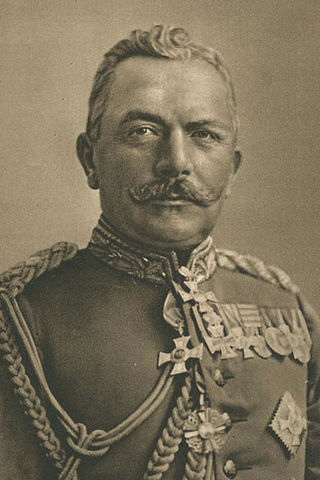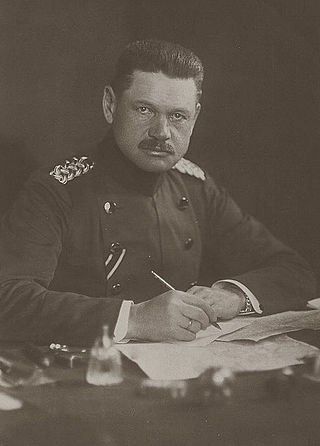
Schutztruppe was the official name of the colonial troops in the African territories of the German colonial empire from the late 19th century to 1918. Similar to other colonial armies, the Schutztruppen consisted of volunteer European commissioned and non-commissioned officers, medical and veterinary officers. Most enlisted ranks were recruited from indigenous communities within the German colonies or from elsewhere in Africa.

The German colonial empire constituted the overseas colonies, dependencies, and territories of the German Empire. Unified in 1871, the chancellor of this time period was Otto von Bismarck. Short-lived attempts at colonization by individual German states had occurred in preceding centuries, but Bismarck resisted pressure to construct a colonial empire until the Scramble for Africa in 1884. Claiming much of the remaining uncolonized areas of Africa, Germany built the third-largest colonial empire at the time, after the British and French. The German colonial empire encompassed parts of several African countries, including parts of present-day Burundi, Rwanda, Tanzania, Namibia, Cameroon, Gabon, Congo, Central African Republic, Chad, Nigeria, Togo, Ghana, as well as northeastern New Guinea, Samoa and numerous Micronesian islands.

Albert Theodor Otto Emmich was a Prussian general who fought in the Franco-Prussian War and was a senior commander in World War I. He was the first recipient of the Pour le Mérite, Prussia's highest military honor, in World War I for his role in the Battle of Liège.

German West Africa (Deutsch-Westafrika) was an informal designation for the areas in West Africa that were part of the German Colonial Empire between 1884 and 1919. The term was normally used for the territories of Cameroon and Togo. German West Africa was not an administrative unit. However, in trade and in the vernacular the term was sometimes in use.

Hans Dominik was a German colonial officer of the Schutztruppe. He was the long-time commander of the Jaunde military station in Kamerun.
Mora is a town in northern Cameroon. Mora has a population of 55,216 making it the 5th biggest city in Far North.

Duke Robert Maria Klemens Philipp Joseph of Württemberg was a member of the House of Württemberg and a Duke of Württemberg.

The Adamawa Wars (1899–1907) were initially a series of military expeditions and border conflicts between the German Schutztruppe in Kamerun and the Fula Sunni Muslim states and tribes that were a part of the Sokoto Empire, particularly the Emirate of Adamawa in the northern half of the region. After these territories were annexed major resistance continued for years and several uprisings occurred.

Walther Gustav Reinhardt was a German officer who served as the last Prussian Minister of War and the first head of the army command within the newly created Ministry of the Reichswehr of the Weimar Republic. During the Kapp Putsch of 1920, Reinhardt remained loyal to the elected government and was one of the few senior officers of the Reichswehr willing to order troops to fire at the revolting units.

Wilhelm Heye was a Prussian and German officer who rose to the rank of Generaloberst and became Chief of the Army Command within the Ministry of the Reichswehr in the Weimar Republic.

The history of rail transport in Namibia began with a small mining rail line at Cape Cross in 1895. The first major railway project was started in 1897 when the German Colonial Authority built the 600 mm gauge Staatsbahn from Swakopmund to Windhoek. By 1902 the line was completed.

Karl Ernst Manfred Freiherr von Richthofen was a German General der Kavallerie during World War I and recipient of the order Pour le Mérite, known informally as the Blue Max. Richthofen was a great uncle of his more famous namesake Manfred von Richthofen, known as the Red Baron, who was his godson and named after him.

The Kamerun campaign took place in the German colony of Kamerun in the African theatre of the First World War when the British, French and Belgians invaded the German colony from August 1914 to March 1916. Most of the campaign took place in Kamerun but skirmishes also broke out in British Nigeria. By the Spring of 1916, following Allied victories, the majority of German troops and the civil administration fled to the neighbouring neutral colony of Spanish Guinea. The campaign ended in a defeat for Germany and the partition of its former colony between France and Britain.

Curt Ernst von Morgen was a Prussian explorer and officer, later General of Infantry during World War I. He was a recipient of Pour le Mérite with Oak Leaves.
The siege of Mora or siege of Moraberg, between Allied and besieged German troops, took place from August 1914 to February 1916 on and around the Mora mountain in northern Kamerun during the Kamerun campaign of the First World War. After more than a year of siege German forces on the mountain surrendered, following the escape of many German troops to the neutral Spanish colony of Río Muni. It was the second longest siege of the war, behind the Siege of Medina.
The Battle of Kusseri between German and French forces took place from late August to 25 September 1914 in Kusseri, northeastern Kamerun during the Kamerun campaign of World War I. The action resulted in the French capture of the Kusseri fort and the German garrison's retreat to Mora.
During the Battle of Banjo or Battle of Banyo, British forces besieged German forces entrenched on the Banjo mountain from 4 to 6 November 1915 during the Kamerun campaign of the First World War. By 6 November much of the German force had deserted, while the rest surrendered. The battle resulted in victory for the Allies and breakdown of German resistance in northern Kamerun.
The VIII Army Corps was a mixed corps of the army of the German Confederation, which was made up of contingents from Württemberg, Baden and Hesse. Until 1830 contingents from Hohenzollern-Sigmaringen, Hohenzollern-Hechingen and Liechtenstein also belonged to this corps.

Frederick Hugh Gordon Cunliffe, (1861-1955) was a British Brigadier who was one of the main British commanders at the Kamerun campaign and earned a key victory at the Siege of Mora.

Hans Gustav Ferdinand Ramsay, from 1911 von Ramsay was an officer in the Imperial German Army and explorer of Africa.















